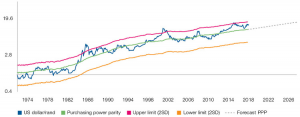Reasons for Investing Offshore
Investors are regularly reminded of the wisdom of investing offshore and not adopting an investment strategy that focuses only on South African assets. In the article below we’ll set out reasons why investors should take a long-term view to fully benefit from the return potential of international assets.
There are a number of compelling reasons for investing offshore.
Briefly, these include:
-
Diversification benefits
Investing in international assets allows for greater diversification, which is a key investment principle for reducing risk. In addition, investing in international markets provides access to countries, currencies, asset classes and industries that are not available locally.
-
Reduced emerging-market risk
SA remains an emerging market, albeit with pockets of first-world industries (such as banking and mining) and infrastructure (for example, roads, ports and railways). By world standards, though, SA is a small economy with a relatively illiquid and volatile stock market.
Interestingly, while the FTSE/JSE all-share index makes up less than 1% of the world’s market capitalisation, SA’s gross domestic product (GDP) comprises only about 0.5% of the world’s GDP.
Why is the size of market capitalisation compared with GDP so high in SA?
The reason is that SA was among the earliest adopters of a market exchange aimed at raising external capital to finance business activity, which happened to be mining at the time. (The JSE was founded by Benjamin Woollan in November 1887 to provide a marketplace for the shares of SA’s many mining and financial companies following the discovery of the Witwatersrand gold fields in 1886.)
It was not until more recently that financial markets geared towards raising external capital became a feature in many other emerging markets, including Russia and China.
Why is this relevant? Index trackers and many global portfolio managers base their allocation to a particular emerging market on relative market capitalisation, not GDP. It is likely that other emerging markets will, over time, see a proportional increase in their market capitalisation in line with their relative GDP, thereby reducing SA’s relative market capitalisation.
Ultimately, this change will likely mean fewer capital flows to SA, which will put pressure on the rand.
-
Reduced currency Risk
All things being equal, economic theory states one can expect a currency to depreciate in line with the differential between that country’s inflation rate and those of its major trading partners. With inflation still hovering closer to the upper end of the South African Reserve Bank’s 3%–6% target, SA’s inflation rate exceeds, by some margin, the inflation rates of its major trading partners. Therefore, over time, the rand can be expected to depreciate against these currencies.
Figure 1 (below) illustrates the overall deteriorating performance of the rand against the US dollar since 1972. The graph also uses the theory of purchasing power parity (PPP) to show the relative cheapness or expensiveness of the rand against the dollar over time. (PPP is a theory stating that exchange rates between two currencies are in equilibrium when their purchasing power is the same in both countries.)

Figure 1: US dollar/rand purchasing power parity. Picture: I-Net Bridge, Bloomberg and Investec Asset Management as at 11.12.18, Log Scale.
When the blue line in figure 1 is above the green line, it suggests the rand is cheap and vice versa. The two grey lines represent two standard deviations – cheap or expensive. This simply means the rand is expected to trade within these bands about 95% of the time.
Currently, therefore, PPP is suggesting that the rand is on the cheap side. However, it is important to consider SA’s worsening terms of trade, general risk aversion and continued US dollar strength on the back of rising US interest rates. All these factors are potentially negative for the rand.
-
Maintenance of ‘hard’ currency spending power
It is important for South Africans who travel abroad or who buy imported items (or any product or service priced in an international currency) to ensure that they maintain (and grow) their spending power in real terms.
A long-term view is required to fully benefit from offshore assets’ return potential. While the case for investing offshore is compelling, it is important to consider where the return from an international investment could come from: the exchange rate and/or the underlying foreign investment.
The impact of exchange-rate risk on a foreign investment should also be an important consideration.
Many South Africans got burnt when they invested offshore in 2001 and 2002 when the rand traded at around R12 to the US dollar. As a result, South African investors now tend to have an underweight exposure to foreign investments.
Studies have shown that when considering the historical returns of foreign investments, the impact of the exchange rate is uncertain and volatile, and that when measured over shorter periods, the exchange rate can have a significant impact on the investment return in rand.
Research indicates it is only over longer periods that the underlying investment contributes more to the return than the exchange rate. Therefore, Salvo Capital is of the opinion that when investing offshore, investors need to take a long-term view to fully benefit from the return potential of the international assets in which they are invested.
Learn More
To learn more about investing offshore and our Salvo Capital Solutions contact any one of our specialized financial advisors or visit our website.




